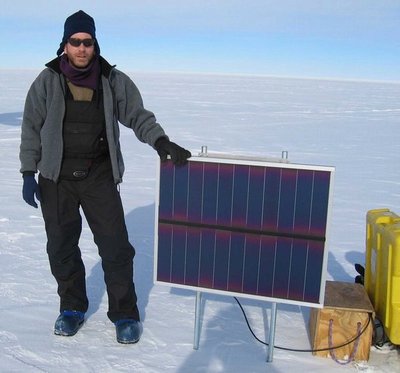March 23, 2006
Greenland’s glaciers pick up pace in surge toward the sea
With warming temperatures as the possible underlying cause, scientists wonder what is pushing Greenland’s glaciers out to sea as much as 50 percent quicker than before.
As a glacier loses large pieces of ice on its leading edge, a process called calving, openings may be created for ice to stream through more quickly, sort of like water flooding through a sudden break in a dike or dam, suggests Ian Joughin, a glaciologist with the University of Washington’s Applied Physics Laboratory.
“Greenland Rumbles Louder as Glaciers Accelerate” is Joughin’s commentary in this week’s Science on work reported by Harvard University’s Goran Ekstrom and co-authors saying that glacier quakes, one way scientists can monitor glacial activity, have increased dramatically. The Ekstrom article says that seismic data from 1993 through 2005 reveals summer glacial seismicity nearly five times greater than in winter, and a rapid increase in seismicity from 2002 onwards, with 2005 producing nearly as many events as the combined total for 1993 through 1996.
The authors of that research article hypothesize that the ice is slipping on growing pockets of meltwater, like a car hydroplaning on rain-slicked streets. The meltwater drains during the summer from the surface of the glacier to the bed through glacial conduits called moulins.
Because calving of Greenland’s fastest-moving glacier, Jakobshavn Isbrae, has an annual variability similar to its glacier quakes, Joughin writes that other explanations may revolve around calving.
“Large calving events alone might yield mass displacements sufficient to produce glacier quakes,” he writes. “Alternatively, changes in glacier geometry after a calving event introduce a force imbalance, which may yield a slip event as new force balance is established.”
Or perhaps glacier quakes are produced by stick-slip events that occur in the normal course of glacier sliding, with only hour-long periods of sticking required to build enough elastic strain to produce a detectable slip event when the ice begins to move again, he says.
Joughin, who published findings two years ago that the Jakobshavn Isbrae glacier had doubled its speed between 1997 and 2003, uses radar images from satellites to monitor the glaciers he studies.
Seismic activity has been monitored locally in Antarctica and elsewhere by placing seismometers on the glaciers. Now the Ekstrom group has determined that glacier quakes could be detected even half a world away by the existing network of seismometers that measures regular earthquakes.
“This teleseismic data provides a powerful new means for monitoring glacial activity,” Joughin says.
###
For more information:
Joughin, (206) 221-3177, ian@apl.washington.edu
Tag(s): glaciers • Ian Joughin • polar science

